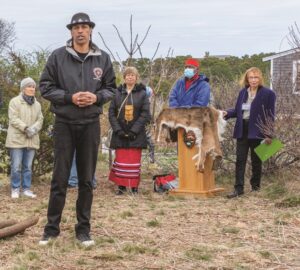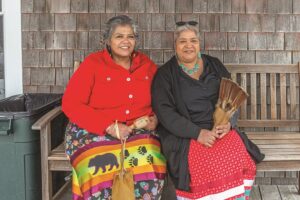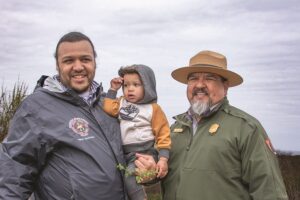TRURO — Brian Weeden, chairman of the Mashpee Wampanoag tribe, asked for a moment of silence to remember the Paomet people. Weeden was standing on the grounds of the Highland House Museum in North Truro, where one of the tribe’s traditional dwellings, a wetu, is being erected. Weeden and other Wampanoag leaders were gathered there on April 22 for a blessing of the land and groundbreaking ceremony.
The Paomet tribe no longer exists. “I almost had tears thinking about them,” said Earl “Soaring Eagle” Cash, medicine man for the Mashpee Wampanoag. “It came across my heart,” he said after leading the ceremony to bless the land where the wetu will be built. “They’re here right now. That’s why we honor our ancestors.”

The wetu, a domed structure traditionally used as a seasonal dwelling, will be built by Annawon Weeden, Brian’s father, with the help of students from Truro Central School. Annawon and Brian Weeden, Cash, and about a dozen others who traveled from Mashpee for the day belong to one of two federally recognized Wampanoag tribes (the other is the Aquinnah on Martha’s Vineyard). In the early 17th century, the Wampanoag comprised at least 24 recorded tribes.
The ceremony on Saturday invoked traditional beliefs and customs that the Paomet likely practiced on this land for thousands of years.
“We’re going to honor the cedar poles for giving their lives to build this wetu,” said Cash to an audience of over 100 people seated in a circle. “They are above us. They are our sisters, our teachers. This is how we honor them,” he said before asking the audience to widen the circle and help bring in long cedar poles to be arranged in groups of two or three, spiraling from the center like spokes of a wheel.
When the activity subsided and a hush settled over the group, Cash began walking around the poles sprinkling tobacco on each one. The Wampanoag clan mothers, a group of four women dressed in colorful skirts, followed him, doing the same. Other tribe members joined in. “Tobacco is male energy,” Cash later explained. It is a sacred crop, he said.
Along with the chief and the medicine man, “the clan mothers keep connections and families together,” said Marlene Lopez, a Rabbit Clan mother. “We show up if people need help or guidance. We’re all-around aunties.”

After the tobacco was dispersed, Cash shrouded himself in a deerskin and lit sage ensconced in a conch shell. He approached his tribe members and fanned smoke from the burning sage over them — a tradition called smudging.
Annawon stood in the center of the circle and spoke a greeting in Wôpanâak, a language revitalized in recent years after generations without living speakers.
He dedicated the event to their late chief, Vernon “Silent Drum” Lopez, who died on April 3 at age 100, and to Susan Howe, the late president of the Truro Historical Society who was instrumental, along with vice president Helen McNeil-Ashton, in planning the wetu project and securing funding for it through the Truro Community Preservation Committee. “She is missed, but I feel her presence,” Annawon said of Howe.
Annawon then walked around the circle fanning the sage smoke over each person, one by one, while Cash waved an eagle feather in the center. “The eagle feather sends your prayers to the creator,” Cash explained after the ceremony. “It’s the bird that flies the highest; it’s so sacred to us.”
The ceremony was slowly paced. At times the clan mothers played hand instruments, but there were also pauses with silence. “It’s not about how fast you do it. It’s about the creator speaking to you to do things,” said Cash. “In our world, when we do things like this, there’s no such thing as time.” The ceremony felt more intuitive than prescribed or liturgical. As Brian Weeden said at the outset, “It’s about what comes to you throughout the ceremony.”
Brian spoke of the spring season as the Wampanoag New Year, a time when “everything comes back to life. We see the herring coming up from the ocean back into the rivers. With new life come new journeys and new beginnings.”

At one point during the ceremony Annawon brought his son and grandson to the center. “We stand here before you as three generations of our tribe,” he said. As the wetu is being built, he said, “I’m inviting each and every one of you to come with your multiple generations and place a tie on this home where the poles intersect, where our lineages and our generations intersect here on this land.”
The ceremony ended with a circle dance open to all. “This dance is a form of us giving back to the Earth,” said Annawon. “We’re trying to caress Mother Earth with our feet.” Roger Williams had seen the exact same dance, he said, and described it in vivid detail. Annawon asked Mayflower descendants to raise their hands. “Don’t be ashamed,” he said, as a few hands went up. “Your ancestors met ours. This dance is a gesture of welcoming.
“We hold hands to contain physical energy,” he continued. Annawon and the Clan Mothers sang in harmony while beating drums; tribal members and the entire audience held hands, stepping side to side in a dance rotating around the cedar poles.
After the ceremony concluded, McNeil-Ashton said, “The Truro wetu will be a real and symbolic presence in our town that honors the indigenous people, the Wampanoag Nation, who have been stewards of this land for thousands of years.”
Chuck Sams, director of the National Park Service, came from Washington, D.C. to attend the event and celebrate Earth Day and National Park Week here. He said the construction of the wetu on National Seashore land is a learning opportunity and represents “restorative justice for land that had originally been taken from tribal people.” The cooperative relationship between the Wampanoag and the Cape Cod National Seashore, he added, is serving as a model for other national initiatives. Funding for Saturday’s ceremony came from the Friends of the Cape Cod National Seashore.
Sams introduced himself as Mockingbird With Big Heart. “I come from the place of the Big Spring, which is now located on the Umatilla Indian Reservation in Northeast Oregon,” he said.
He told a story of coming to Cape Cod almost 30 years ago. When one of his tribal elders heard he would visit the area, she ran to her car and came back with a bundle to give to the first Wampanoag elder he would meet. “We would not have our daylight if they did not pray every morning and bring the sun back to us,” said the woman.
“It’s about the connection to this area and this place,” said Brian Weeden. At one point all this was Wampanoag territory, he said.
“As a people, we have undergone so many different things and overcome so many different things,” said Cash. “We’re not even supposed to be here. But here we are. Through the love of our ancestors, the love of our elders, the love of each other, and of our children.”
Editor’s note: An earlier version of the article, published in print on April 27, incorrectly identified the source of funding for the wetu project as the Truro Historical Commission. It was the Truro Community Preservation Committee.



